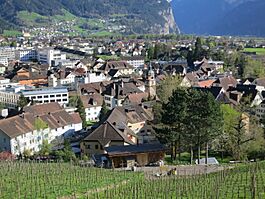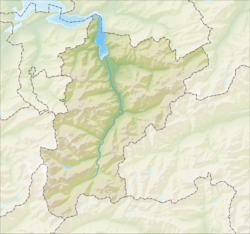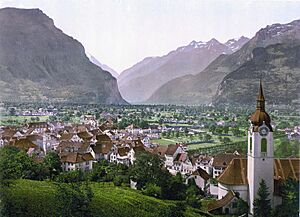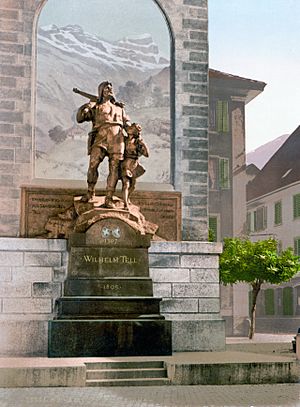Altdorf, Uri facts for kids
Quick facts for kids
Altdorf
|
||
|---|---|---|
 |
||
|
||
| Country | Switzerland | |
| Canton | Uri | |
| District | n.a. | |
| Area | ||
| • Total | 10.21 km2 (3.94 sq mi) | |
| Elevation
(Church St. Martin)
|
458 m (1,503 ft) | |
| Highest elevation
(Eggberge)
|
1,720 m (5,640 ft) | |
| Lowest elevation
(Wildried)
|
432 m (1,417 ft) | |
| Population
(Dec 2020 )
|
||
| • Total | 9,565 | |
| • Density | 936.8/km2 (2,426.4/sq mi) | |
| Demonym(s) | German: Altdorfer(in) | |
| Postal code |
6460
|
|
| Surrounded by | Attinghausen, Bürglen, Flüelen, Seedorf | |
| Twin towns | Altdorf b. Nürnberg (Germany) | |
Altdorf is a town in Switzerland. It is the capital city of the Uri canton. This means it's the main town where the government of Uri is located. Altdorf is famous because of the legend of William Tell. The story says he shot an apple off his son's head right here!
Altdorf is located on the eastern side of the Reuss River. It's about 2 kilometers south of where the river flows into Lake Lucerne. The town is also important because it's near two big mountain passes: Saint Gotthard to the south and the Klausen Pass to the east. It's also the last stop on the Gotthard railway before the train enters the Gotthard Base Tunnel. This tunnel is the longest railway tunnel in the world!
The main language spoken in Altdorf is a local form of German.
Contents
Geography of Altdorf
The town of Altdorf covers an area of about 10.21 square kilometers. The main part of the town is 458 meters (about 1,500 feet) above sea level. It sits on a flat area of land made by the river, between the Reuss River and a steep hill called Rossstock.
Higher up, about 1,000 meters (3,280 feet) above the town, are the small villages and pastures of Eggbergen. These also belong to Altdorf.
- About 36% of Altdorf's land is used for farming, mostly for fruit trees or grapevines.
- Around 37–39% is covered by forests.
- About 23% has buildings or roads.
- The rest of the land is rivers, glaciers, or mountains.
Altdorf is next to several other towns. These include Attinghausen and Seedorf to the west, Flüelen to the north, Bürglen to the east and south, and Schattdorf to the south.
History of Altdorf
The first signs of people living in Altdorf are from about 2,300 years ago. These include old bronze axes and iron tools. The first people settled in the forest and then moved closer to the Reuss River. However, the river often flooded, destroying homes. People had to move back to the "old town," which might be how Altdorf got its name.
After the Roman Empire ended, people from the Roman culture in Altdorf mixed with Germanic groups around the 600s AD. We know this from a grave of a horseman found in St. Martin's Church, dating to that time.
The name Alttorf was first written down in 1223. Sometimes, in older writings, it was just called Uri.
People of Altdorf
Altdorf has a population of about 9,000 people. Around 14.8% of the people living here are from other countries. The population has been slowly growing over the last few years.
Most people in Altdorf speak German (about 88.3%). Other languages spoken include Serbo-Croatian (4.2%) and Italian (2.5%).
Many adults in Altdorf (aged 25–64) have finished high school or gone on to higher education, like university.
The unemployment rate in Altdorf is low, around 1.45%. Many people work in different jobs:
- Some work in farming.
- Many work in factories or making things.
- Even more people work in services, like shops, offices, or tourism.
Cool Places to See
Tell Monument
The main square in Altdorf is where the famous legend of William Tell took place. He is said to have shot an apple off his son's head here. In 1895, a bronze statue of William Tell was put up to remember this story.
Close by, a theater opened in 1899. It was built to perform the play Wilhelm Tell by Friedrich Schiller.
Museums and Art
There is a museum in Altdorf called the Historisches Museum. It opened in 1905 and has old items from the area, weapons, and furniture. It also has paintings of important people from Uri, including some by Felix Maria Diogg. You can also see several paintings by the American artist Adolfo Müller-Ury, whose family came from nearby.
More recently, the town opened the Haus für Kunst Uri. This is an art space in an old house that has been updated. It shows art by Swiss and international artists.
Climate
Altdorf has a climate that is often described as a "Marine West Coast Climate." This means it usually has mild temperatures and rain throughout the year.
Between 1961 and 1990, Altdorf had rain on about 133.7 days each year. The wettest month was August. The driest month was February.
| Climate data for Altdorf (1991–2020) | |||||||||||||
|---|---|---|---|---|---|---|---|---|---|---|---|---|---|
| Month | Jan | Feb | Mar | Apr | May | Jun | Jul | Aug | Sep | Oct | Nov | Dec | Year |
| Mean daily maximum °C (°F) | 5.0 (41.0) |
6.4 (43.5) |
10.8 (51.4) |
15.0 (59.0) |
19.3 (66.7) |
22.4 (72.3) |
24.1 (75.4) |
23.6 (74.5) |
19.4 (66.9) |
14.9 (58.8) |
9.1 (48.4) |
5.4 (41.7) |
14.6 (58.3) |
| Daily mean °C (°F) | 1.6 (34.9) |
2.4 (36.3) |
6.1 (43.0) |
9.9 (49.8) |
14.0 (57.2) |
17.3 (63.1) |
18.9 (66.0) |
18.5 (65.3) |
14.7 (58.5) |
10.7 (51.3) |
5.7 (42.3) |
2.3 (36.1) |
10.2 (50.4) |
| Mean daily minimum °C (°F) | −2.1 (28.2) |
−1.8 (28.8) |
1.1 (34.0) |
4.4 (39.9) |
8.6 (47.5) |
12.0 (53.6) |
13.7 (56.7) |
13.4 (56.1) |
9.9 (49.8) |
6.3 (43.3) |
1.8 (35.2) |
−1.3 (29.7) |
5.5 (41.9) |
| Average precipitation mm (inches) | 70 (2.8) |
59 (2.3) |
72 (2.8) |
81 (3.2) |
117 (4.6) |
138 (5.4) |
141 (5.6) |
154 (6.1) |
105 (4.1) |
84 (3.3) |
81 (3.2) |
83 (3.3) |
1,186 (46.7) |
| Average snowfall cm (inches) | 13 (5.1) |
11 (4.3) |
4 (1.6) |
2 (0.8) |
0 (0) |
0 (0) |
0 (0) |
0 (0) |
0 (0) |
1 (0.4) |
4 (1.6) |
10 (3.9) |
45 (18) |
| Average precipitation days (≥ 1.0 mm) | 9.2 | 8.6 | 9.7 | 9.8 | 12.1 | 14.1 | 14.1 | 13.3 | 10.2 | 8.7 | 9.4 | 10.0 | 129.2 |
| Average snowy days (≥ 1.0 cm) | 3.1 | 2.7 | 1.3 | 0.2 | 0.0 | 0.0 | 0.0 | 0.0 | 0.0 | 0.1 | 1.0 | 2.4 | 10.8 |
| Average relative humidity (%) | 78 | 74 | 70 | 66 | 69 | 73 | 74 | 76 | 78 | 79 | 79 | 80 | 75 |
| Mean monthly sunshine hours | 49 | 83 | 124 | 143 | 154 | 160 | 169 | 159 | 136 | 107 | 56 | 37 | 1,376 |
| Percent possible sunshine | 36 | 42 | 47 | 51 | 45 | 46 | 48 | 52 | 52 | 46 | 36 | 30 | 46 |
| Source: MeteoSwiss | |||||||||||||
International Friends
Altdorf has a special friendship with another town. This is called a "twin town" or "sister city" relationship.
- Altdorf is twinned with Altdorf bei Nürnberg in Germany. They have been friends since 1971.
Getting Around
Altdorf has its own train station, which is part of the Gotthard railway. This makes it easy to travel to and from the town.
In 1899, a road was built from Altdorf through the Schächental valley and over the Klausen Pass. This road connects Altdorf to the village of Linthal.
There used to be an electric tramway in Altdorf. It connected the town center to the Fluelen railway station from 1906 until 1951. After that, buses took its place.
Famous People from Altdorf
Many interesting people have connections to Altdorf:
- Sebastian Peregrin Zwyer (1597–1661) was a Swiss military leader and politician. He died in Altdorf.
- Henry Haller (born 1923) was a chef who worked at the White House for 22 years. He was born in Altdorf.
- Beat Streuli (born 1957) is a visual artist who uses photos and videos in his work. He was born in Altdorf.
- Luzia Zberg (born 1970) is a retired professional cyclist. She was born in Altdorf.
- Beat Zberg (born 1971) is a retired professional road bicycle racer. He was born in Altdorf.
- Matthias Simmen (born 1972) is a retired Swiss biathlete who competed in the Winter Olympics. He was born in Altdorf.
- Markus Zberg (born 1974) is a retired professional road bicycle racer. He was born in Altdorf.
See Also
 In Spanish: Altdorf (Uri) para niños
In Spanish: Altdorf (Uri) para niños







